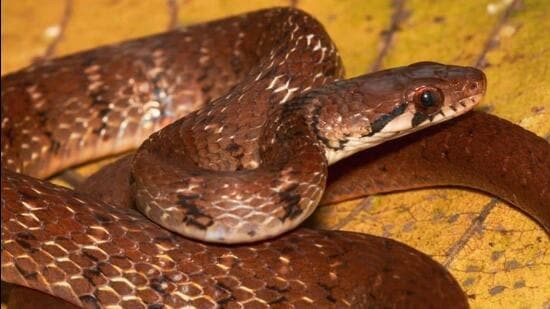Description

Disclaimer: Copyright infringement not intended.
Context
- A recent study led by researchers from Gujarat, Maharashtra, the United Kingdom, and Germany has unveiled a new genus and species of colubrid snakes within the ecologically diverse Western Ghats.
- The discovery was published in the international journal Taxonomy.
Details
Genus and Species
- The newfound snake genus has been christened "Sahyadriophis," a fusion of the Sanskrit term for the Western Ghats, "Sahyadri," and the Greek term for snakes, "Ophis."
- This genus houses a new species named "Sahyadriophis Uttaraghati," also known as the Northern Sahyadri keelback.
Discovery and Habitat
- The team stumbled upon this new genus and species during specialized surveys aimed at documenting the Western Ghats' biodiversity.
- The new species, Sahyadriophis Uttaraghati, thrives in the northern regions of the Western Ghats.
Distinct Features and Naming
- Sahyadriophis Uttaraghati stands out due to a higher count of subcaudal scales on its tail's underside, known as subcaudals, and a notably elongated tail.
- Unlike its Southern counterpart, Sahyadriophis beddomei, this new species possesses these distinct characteristics.
Behavior and Diet
- Snakes belonging to this newly discovered genus exhibit heightened activity during the monsoon seasons.
- Their diet primarily consists of frogs and their eggs. Despite their feeding habits, these snakes are docile and rarely bite when handled.
Biogeographic Significance
- The researchers postulate that this newly uncovered species lineage diverged from its common ancestors around 20-30 million years ago.
- The species' presence in the northern parts of the Western Ghats hints at the potential for distinct biogeographic barriers in the region.
Unanswered Questions and Implications
- The study raises intriguing questions regarding the endemism of this lineage to the Western Ghats.
- The researchers speculate on potential connections between the snake's habitat and the species of frogs it preys on.
- More extensive sampling is necessary to unravel these mysteries.

Conclusion
The discovery of this novel Western Ghats-endemic genus underscores the untapped potential for identifying additional distinct lineages. Notably, this new species not only diverges genetically but also showcases unique morphological attributes, providing valuable insights into the region's biodiversity.
|
PRACTICE QUESTION
Q. A new genus and species of colubrid snakes were recently discovered in the Western Ghats of India. Consider the following statements:
1. The new genus is named "Sahyadriophis," derived from the Sanskrit word "Sahyadri" and the Greek word "Ophis."
2. The newly discovered species, "Sahyadriophis Uttaraghati," is also known as the Southern Sahyadri keelback.
3. The snakes of the newly discovered genus primarily feed on frogs and their eggs during the monsoon seasons.
Which of the statements above is/are correct?
A) Only 1
B) Only 2
C) Only 1 and 3
D) 1, 2, and 3
Answer: C)
|
https://www.hindustantimes.com/cities/others/new-genus-and-species-of-colubrid-snakes-discovered-in-western-ghats-india-101692952992771.html












